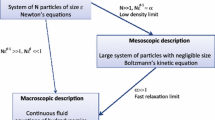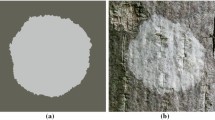Abstract
A model of deterministic surface growth studied by Krug and Spohn, a model of the annihilating reactionA+B→inert studied by Elskens and Frisch, a one-dimensional three-color cyclic cellular automaton studied by Fisch, and a particular automaton that has the number 184 in the classification of Wolfram can be studied via a cellular automaton with stochastic initial data called ballistic annihilation. This automaton is defined by the following rules: At timet=0, one particle is put at each integer point of ℝ. To each particle, a velocity is assigned in such a way that it may be either +1 or −1 with probabilities 1/2, independent of the velocities of the other particles. As time goes on, each particle moves along ℝ at the velocity assigned to it and annihilates when it collides with another particle. In the present paper we compute the distribution of this automaton for each timet ∈ ℕ. We then use this result to obtain the hydrodynamic limit for the surface profile from the model of deterministic surface growth mentioned above. We also show the relation of this limit process to the process which we call moving local minimum of Brownian motion. The latter is the processB min x ,x ∈ ℝ, defined byB min x ≔min{B y ;x−1≤y≤x+1} for everyx ∈ ℝ, whereB x ,x ∈ ℝ, is the standard Brownian motion withB 0=0.
Similar content being viewed by others
References
P. Billingsley,Convergence of Probability Measures (Wiley, New York, 1968).
E. Ben-Naim, S. Redner, and F. Leyvraz, Decay kinetics of ballistic annihilation,Phys. Rev. Lett. 70:1890–1893 (1993).
Y. Elskens and H. L. Frisch, Annihilation kinetics in the one-dimensional ideal gas,Phys. Rev. A 31(6):3812–3816 (1985).
W. Feller,An Introduction to Probability Theory and Its Application, Vol. I (Wiley, New York, 1964).
R. Fisch, Clustering in the one-dimensional three-color cyclic cellular automaton,Ann. Prob. 20(3):1528–1548 (1992).
B. V. Gnedenko and A. N. Kolmogorov,Limit Distributions for Sums of Independent Random Variables (Addison-Wesley, Reading, Massachusetts, 1954).
I. Karatzas and S. E. Shreve,Brownian Motion and Stochastic Calculus (Springer-Verlag, Berlin, 1991).
J. Krug and H. Spohn, Universility classes for deterministic surface growth,Phys. Rev. A 38:4271–4283 (1988).
J. Neveu and J. Pitman, Renewal property of the extrema and tree property of the excursion of a one-dimensional Brownian motion, inSéminare de Probabilités XXIII, J. Azéma, P. A. Meyer, and M. Yor, eds. (Springer-Verlag, Berlin, 1989).
J. Neveu and J. Pitman, The branching process in a Brownian excursion, inSéminare de Probabilités XXIII, (Springer-Verlag, 1989).
S. Wolfram, Statistical mechanics of cellular automata,Rev. Mod. Phys. 55:601 (1983).
Author information
Authors and Affiliations
Rights and permissions
About this article
Cite this article
Belitsky, V., Ferrari, P.A. Ballistic annihilation and deterministic surface growth. J Stat Phys 80, 517–543 (1995). https://doi.org/10.1007/BF02178546
Received:
Accepted:
Issue Date:
DOI: https://doi.org/10.1007/BF02178546




